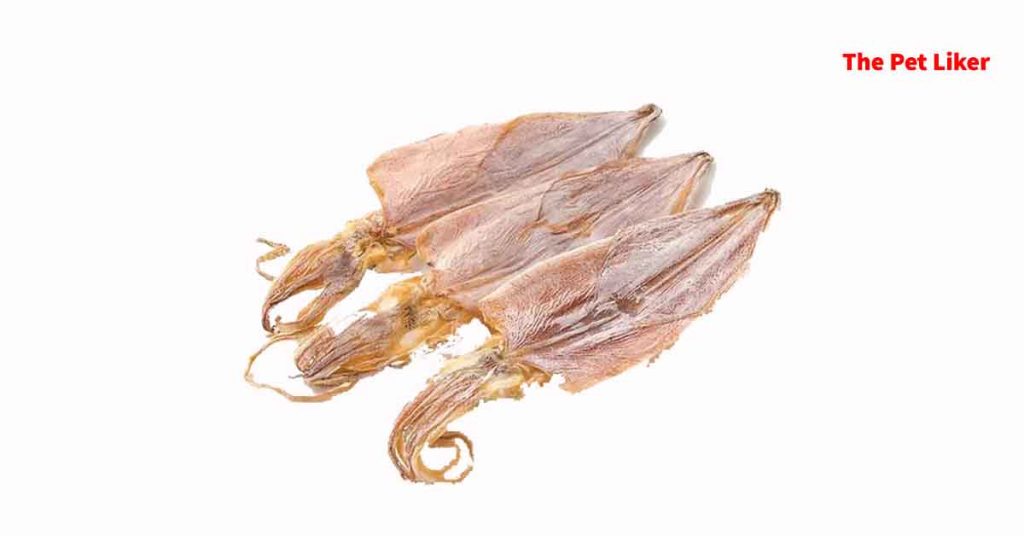As dog owners, we strive to provide our four-legged friends with the best nutrition possible.
However, with so many different types of food available, it can be confusing to know what is safe and healthy for our pets.
So, can dogs eat dried squid? Is it safe to feed them?
In this article, we will dive into the pros and cons of feeding dried squid to your dog.
What is Dried Squid?
Dried squid is a seafood snack that is popular in many countries around the world.
It is made by drying and salting fresh squid, which removes most of the moisture and preserves the meat.
Dried squid is available in various forms, such as whole, sliced, shredded, and flavored.
Types of Dried Squid
There are different types of dried squid available, depending on the species, processing method, and origin. Some common types of dried squid include:
- Japanese or Korean squid: Thinly sliced and seasoned with soy sauce or sugar
- Thai or Filipino squid: Whole or sliced and coated with chili or other spices
- Chinese or Taiwanese squid: Whole or shredded and marinated with spices or sauces
Nutritional Value of Dried Squid
Dried squid is a rich source of protein, vitamins, and minerals. It contains essential amino acids, such as lysine and methionine, that are important for muscle growth and repair.
Dried squid also has low fat and calorie content, which makes it a good snack choice for dogs that are on a weight-management diet.
Can Dogs Eat Dried Squid?
Yes, dogs can eat dried squid in moderation, but there are some factors to consider before giving it to them.
Factors to Consider Before Feeding Dried Squid to Your Dog
- Age and health condition: Puppies, senior dogs, and dogs with a history of digestive issues or allergies may not tolerate dried squid well.
- Sodium level: Dried squid is high in sodium, which can cause dehydration and kidney problems in dogs that are prone to these issues.
- Allergy risk: Some dogs may be allergic to squid or seafood in general, leading to symptoms such as vomiting, diarrhea, itching, or swelling.
- Digestion trouble: The tough texture of dried squid can be hard for some dogs to chew and digest, leading to bloating, constipation, or diarrhea.
- Choking hazard: The small size and shape of dried squid can pose a choking risk for dogs, especially those who gulp their food quickly.
Benefits of Feeding Dried Squid to Your Dog
Feeding dried squid to your dog in moderation can have some health benefits, such as:
- Rich source of protein: Dried squid contains about 60-70% protein, which helps build and maintain strong muscles and tissues in dogs.
- Low fat and calorie content: Dogs that need to lose weight or maintain a healthy weight can benefit from snacks that are low in fat and calories, such as dried squid.
- Boosts the immune system: Dried squid is rich in antioxidants and vitamins, such as vitamin B12 and selenium, that support the immune system and prevent diseases.
- Promotes healthy skin and coat: The high protein and omega-3 fatty acids in dried squid can help keep your dog’s skin and coat healthy and shiny.
Risks of Feeding Dried Squid to Your Dog
Feeding dried squid to your dog in excess or without considering the above factors can lead to some risks, such as:
- High sodium content: Too much sodium in your dog’s diet can cause excessive thirst, urination, and dehydration, as well as increase the risk of kidney disease and heart problems.
- Risk of allergic reactions: Some dogs may be allergic to squid or seafood in general, which can cause mild to severe symptoms such as itching, vomiting, diarrhea, or anaphylaxis.
- Possible digestion problems: The tough texture of dried squid can be hard for some dogs to chew and digest, especially if they have a sensitive stomach or underlying digestive issues.
- Risk of choking: The small size and shape of dried squid can pose a choking risk for dogs, especially those who don’t chew their food properly or have a tendency to swallow large chunks.
Alternatives to Dried Squid
If you’re not sure whether dried squid is suitable for your dog or if you want to try other snack options, here are some alternatives to consider:
- Other nutritious snacks for dogs: Some healthy and safe snacks that you can give your dog include fresh fruits and vegetables, such as apples, carrots, and green beans, plain cooked meat or fish, and commercial dog treats that are low in fat and salt.
- Foods that are harmful to dogs: Avoid giving your dog foods that are toxic to them, such as grapes, raisins, chocolate, onions, garlic, and anything that contains xylitol, caffeine, or alcohol.
How to Feed Dried Squid to Your Dog
If you’ve decided to give dried squid to your dog, here are some tips on how to do it safely:
Appropriate Quantity
The amount of dried squid that you can give your dog depends on their size, age, and health condition.
As a general rule, you should limit the snack to no more than 10% of your dog’s daily caloric intake, and make sure to balance it with their regular meals.
Ways to Serve Dried Squid to Your Dog
You can serve dried squid to your dog in various ways, such as:
- Whole or sliced pieces as a standalone snack
- Mixed with their regular food as a flavor enhancer
- Frozen or refrigerated for a refreshing treat during hot days
- Soaked in water for a softer texture that is easier to chew
Precautions to Take When Feeding Dried Squid to Your Dog
To avoid any issues with feeding dried squid to your dog, you should:
- Always supervise your dog while they’re eating, to prevent choking or other accidents.
- Start with a small amount of dried squid and monitor your dog’s reaction, such as any signs of allergy, digestive upset, or discomfort.
- Gradually increase the amount of dried squid over time, if your dog tolerates it well, and adjust their intake based on their overall health and activity level.
- Store dried squid in an airtight container in a cool, dry place, away from moisture and pets.
Preparing Dried Squid for Your Dog
Before giving dried squid to your dog, you should prepare it properly to ensure its safety and palatability.
Here’s how:
How to Prepare Dried Squid for Dogs
- Rinse the dried squid thoroughly with water to remove any salt or dust.
- Soak the dried squid in water or low-sodium broth for a few hours or overnight, to reduce its saltiness and soften its texture.
- Cut the dried squid into small, bite-sized pieces that are easy for your dog to eat and digest.
- Check for any bones or foreign objects in the dried squid, and remove them if necessary.
How to Preserve Dried Squid
To preserve the quality and freshness of dried squid, you should:
- Store it in an airtight container or sealed bag, to prevent exposure to air and moisture.
- Keep it in a cool, dry place, away from sunlight and heat sources.
- Use it within its expiration date or within a reasonable period of time, to avoid any spoilage or contamination.
Frequently Asked Questions
Here are some common questions that dog owners may have regarding feeding dried squid to their dogs:
Can Dogs Eat Other Types of Seafood?
Dogs can eat some types of seafood that are safe and healthy for them, such as plain cooked shrimp, salmon, or tuna. However, you should avoid giving them seafood that is high in mercury, such as swordfish or tilefish, and seafood that is raw or undercooked, as it may contain harmful bacteria or parasites.
What to Do if My Dog Suffers an Allergic Reaction?
If you suspect that your dog is having an allergic reaction to dried squid or any other food, you should seek veterinary attention immediately.
Allergic reactions can be life-threatening if not treated promptly and may require medications such as antihistamines or epinephrine.
In the meantime, you can remove the food from your dog’s access and monitor their symptoms closely.
How Much Dried Squid Can I Give to My Dog?
The amount of dried squid that you can give your dog depends on their size, age, and health condition, as well as the quality and type of dried squid.
As a general guideline, you should give your dog dried squid in moderation, as a snack or treat, and balance it with their regular meals.
Most adult dogs can safely consume up to 1-2 pieces of dried squid per day, but you should consult with your veterinarian first.
What Are the Signs of Choking in Dogs?
The signs of choking in dogs can vary depending on the severity and location of the obstruction. Some common signs of choking include:
- Coughing, gagging, or making choking sounds
- Pawing at the mouth or neck
- Difficulty breathing or swallowing
- Blue or pale gums or tongue
- Loss of consciousness or collapse
If you suspect that your dog is choking, you should act quickly to remove the obstruction or seek veterinary care immediately.
Conclusion
I hope now you got a clear concept regarding “Can dogs eat dried squid?”
Dried squid can be a nutritious and tasty snack for dogs, but it should be given in moderation, taking into account the dog’s health condition and dietary needs.
If you decide to feed dried squid to your dog, make sure to prepare it properly, supervise your dog while eating, and watch for any signs of allergic reactions, digestive upset, or choking.
As always, consult with your veterinarian before introducing any new food or treat to your dog’s diet.
Thank you so much for reading our blog. Always stay with The Pet Liker.


